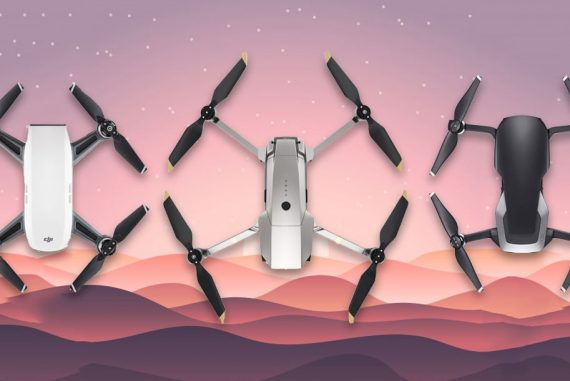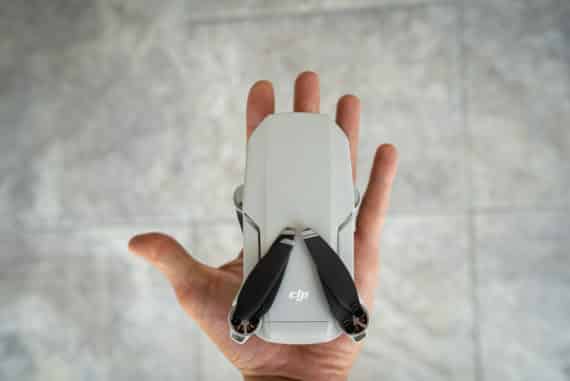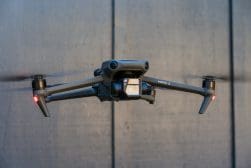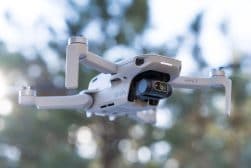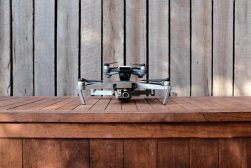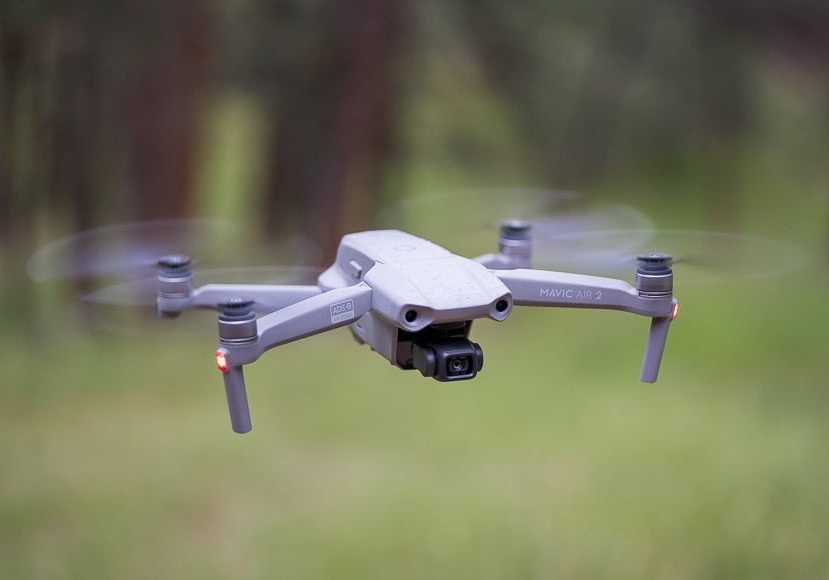
DJI Mavic Air 2 Review
Check out this real-world review of the DJI Mavic Air 2 to find out if this compact but powerful drone (48 megapixels!) is worth the spend!
The DJI Mavic Air 2 is an incredible innovation from DJI. It combines all the brand’s previous improvements and iterations into a small but powerful package.
It’s perfect for the photographer or creator who wants professional-level features in a compact body. With impressive flight time, 48-megapixel still images, and 4k 60fps video, this drone packs a punch but won’t weigh down your camera bag.

Capture butter-smooth 4k video and impressive aerial images with this 48-megapixel gem.
It’s also great for the solo creator who wants to capture footage of themselves with the intelligent flight modes and obstacle avoidance. The object tracking is very smart and easy to use.
With tremendous improvement over the previous Mavic Air, the DJI Mavic Air 2 is excellent value and will likely be one of the most popular drones available here in 2024.
DJI Mavic Air 2 Drone Specs
- Impressive photo/video specs
- Long battery life
- Rugged design
- Sometimes slow GPS signal
- No exposure dial on controller
- No digital display on controller
Maximum Speed: 43 mph / 19 m/s
Maximum Flight Time: 34 Minutes
Hovering Accuracy: ±0.33′ / 0.1 m
Maximum Range: 6.21 Miles / 10 km
Sensor: 1/2″ CMOS
Effective Pixels: 48 MP
Focal Length: 24mm (35mm Equivalent)
Aperture: f/2.8 fixed
Minimum Focusing Distance: 3.3′ / 1.0 m
ISO Range: 100 to 6400
Max Photo Resolution: 8000 x 6000
Photo Format: JPEG, DNG
Overall Dimensions: 3.8 x 3.3 x 7.1″ / 97 x 84 x 180 mm (Folded)
Weight: 1.25 lb / 570 g
Build & Appearance
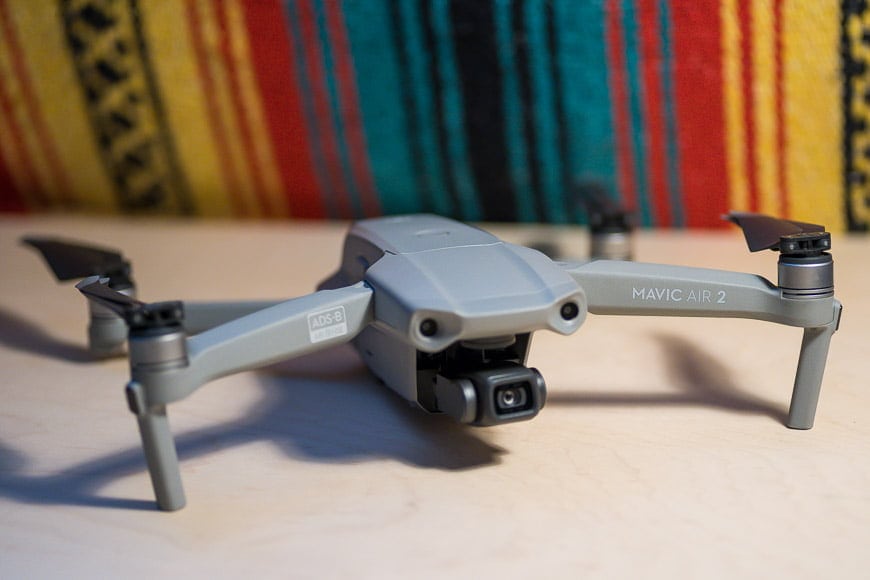
When I first took the DJI Mavic Air 2 out of the box, I was impressed by the build quality. It stood out as a step forward for DJI in terms of build.
It closely resembles the larger Mavic Pro 2 in terms of build and appearance. All the hinges and components feel snug and really well built.
The DJI Mavic Air 2 retains many of the design elements of the Mavic Pro 2 with a much more compact profile. The arms fold out in the same way, the battery has a similar mount, and the rectangular camera design makes it look like a mini version of its big brother.
While the original Mavic Air looked and felt more like a toy drone, the Mavic Air 2 feels like a professional-level drone in a very compact package.
The only thing that isn’t compact about the DJI Mavic Air 2 is the controller. It’s much larger than other DJI controllers and is comparable to the DJI Smart Controller.
While it doesn’t offer the same features as other controllers (no exposure dial or display), it does have a very ergonomic feel. More details on that below.
(If you’re looking for something even smaller, check out our review of the DJI Mavic Mini and Mini 2.)
Ergonomics & Handling
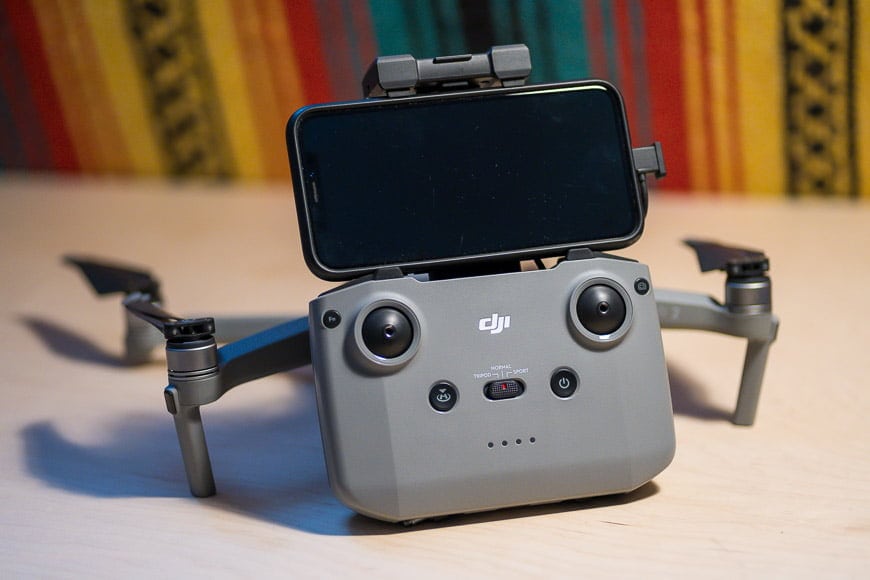
The DJI Mavic Air 2 controller has a nice balance in your hands and gives you a nice grip allowing you to maneuver the controls smoothly.
In addition to improved ergonomics, the controller has a much better phone mount and improved connectivity to the drone with OccuSync 2.0 (claiming up to 10km of range).
The top mount of the phone feels much more natural to fly because the screen is above your hands at a more comfortable viewing angle.
The other major improvement with the controller is battery life. The larger controller has a much better battery life and can even charge my phone which helps to ensure that I’m never limited by phone battery.
The control sticks mount conveniently on the bottom edge of the controller and all the functions are readily available on the face of the controller or on the top edge where your fingers naturally rest.
My only complaint is that despite the improved controller design, it seems to take longer than normal to acquire GPS signal.
This results in a slight delay in flying which can be frustrating if the light is changing quickly. This could have been specific to my usage (usually in remote areas) or something that will be improved with future firmware updates.
Although the controller feels a bit oversized compared to the very compact drone, I think the designers at DJI were prioritizing comfort and function over size/weight. Though it takes up more space than I would like in my camera bag, I appreciate the ergonomics while flying.
The DJI Fly App is very easy to use and intuitive. All the functions I’m familiar with are readily accessible and the drone flies extremely well right out of the box.
On other DJI drones, there may be some tuning required to get smooth movements in your footage, but the DJI Mavic Air 2 feels smooth and responsive with default settings.
One last function that I appreciate is the inclusion of a tripod mode on the mode switch. Other drones I’ve used only have normal/sport modes but tripod mode is a handy feature to be able to turn on if you’re shooting a timelapse or if you want to get super smooth motion in your video.
Focus Performance
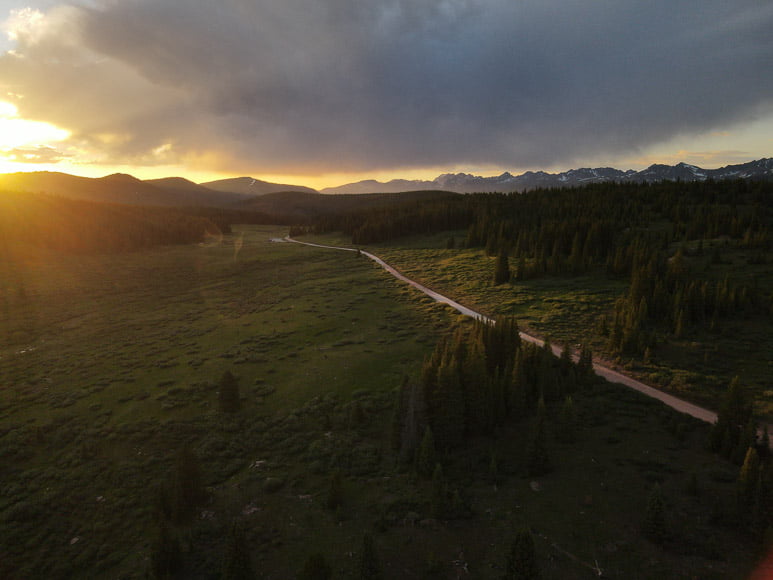
DJI Mavic Air 2 | 1/100 f/2.8 ISO 100
The DJI Mavic Air 2 has a fixed focus to ensure that all your images will be sharp. This feature is very helpful and makes shooting photos and videos fast and efficient.
There’s no lag while you wait for the subject to be in focus and you can shoot video without having to worry about changing your focus point.
The only downside to the fixed focus is that it requires a smaller sensor. The half-inch sensor makes fixed focus possible but larger drones with larger sensors will usually have better image quality (e.g. the one-inch sensor on the Mavic Pro 2).
Another thing to note about the DJI Mavic Air 2 is that it has a fixed aperture of f/2.8. With this, you’ll likely want to use a fixed or variable ND filter to get a natural shutter speed while shooting video (1/50 or 1/60 if shooting at 24 fps or 30 fps).
Another advantage of using a filter is the possibility of getting a circular polarizer so that you’ll get more vibrant colors and less reflection.
Low Light Performance
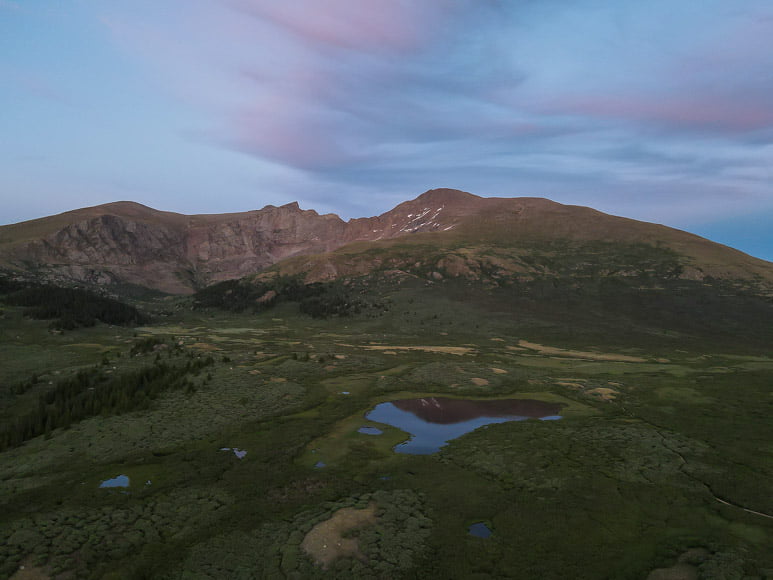
DJI Mavic Air 2 | 1/15 f/2.8 ISO 240
Because of the relatively small sensor size, I wasn’t expecting a lot in terms of low light performance out of the Mavic Air 2.
The other factor to consider is that you really don’t need exceptional low light performance unless you’re planning to shoot fast action after sunset.
The above landscape image was captured at 1/15th of a second and still remained sharp. I kept the ISO low to reduce noise in the image which caused the shutter speed to drop. If there had been a moving subject in the image, it would have been blurry, but the settings worked fine for this landscape.
I never find myself needing to go above ISO 400, and at that setting, the images look great. With a light noise reduction preset applied in Lightroom, digital noise is not a concern.
Image Quality
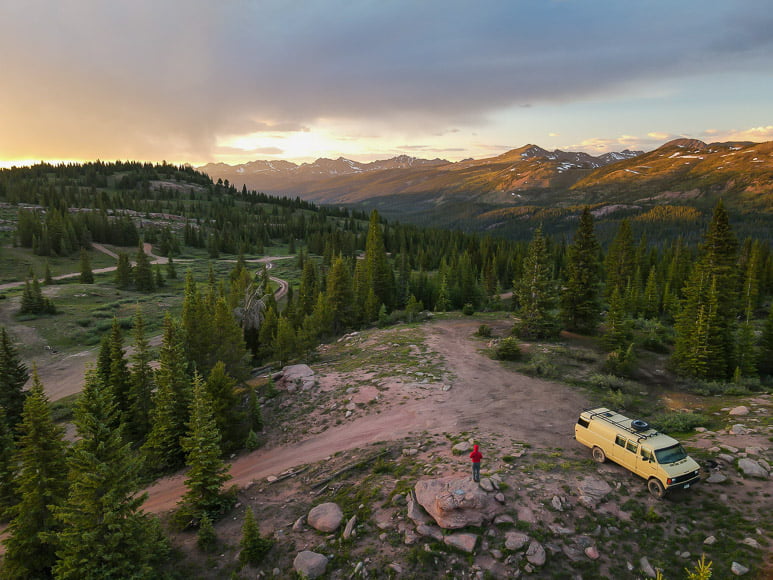
DJI Mavic Air 2 | 1/100 f/2.8 ISO 100
Image quality is what separates the DJI Mavic Air 2 from its predecessor. I am very impressed by the quality of the JPEG and RAW files.
First off, the dynamic range is outstanding, especially with the HDR video function enabled.
It’s able to capture a bright sunset while still having enough detail in the shadows to create a balanced image. It does this while maintaining a relatively natural-looking image.
When shooting still images, you have the choice to shoot standard 12 or 48-megapixel RAW or JPEG files.
The 12-megapixel sensor is utilizes Quad Bayer technology to split the readout of the image, effectively quadrupling its resolution. With this mode enabled you get images that are a whopping 8,000 pixels on the long edge!
One thing to note is that the sensor has a 4:3 aspect ratio, and capturing images at the 16:9 aspect ratio will just digitally crop your photos, leaving you less resolution to work with.
I was really excited about the potential usage of these files, which allow me to make much larger prints and to deliver drone images that are more than adequate for almost any scenario.
Additionally, they can be cropped substantially while still retaining lots of detail.
Initially, I was skeptical that there would be some major sacrifices in quality or dynamic range when shooting these large images but I’m happy to report that they’re very usable and don’t have many drawbacks.
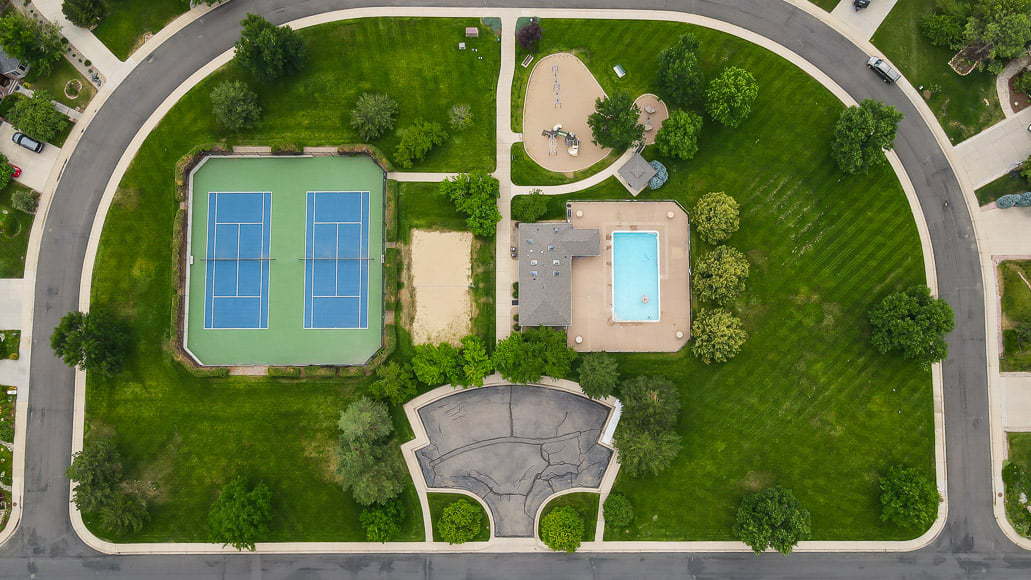
DJI Mavic Air 2 | 1/250 f/2.8 ISO 100 | 16:9 crop mode
In addition to the still image upgrades, the DJI Mavic Air 2 also offers 4k 60p video. This allows for slow-motion which can be very fun if you’re capturing dynamic action sports.
The flexibility of a drone to capture images and video is so versatile. With the impressive image quality of the DJI Mavic Air 2, I found myself thinking more and more about the possibilities.
Previous drones have had limited image quality and resolution, but the 48-megapixel stills and 4k HDR video capture with this drone open up the possibilities for creative expression.
Overall Performance
The overall performance of the DJI Mavic Air 2 is impressive. In addition to the image quality details listed above, it has quite a few impressive specs.
With a flight time up to 34 minutes, this drone gives you the capacity to realistically get multiple flights on one charge. With the fly-more kit, you almost never have to worry about being low on battery!
The other big performance improvement is with the tracking functionality.
It’s easier than ever to shoot interesting video as a solo creator using the intelligent tracking modes. The drone flies itself and easily dodges objects even in tricky settings.
Another welcome performance improvement is in the low operating sound of the DJI Mavic Air 2. The new design has a decreased propeller noise of approximately 10-20dB depending on the situation.
This allows you to be less distracting when flying near other people.
Other Useful Features
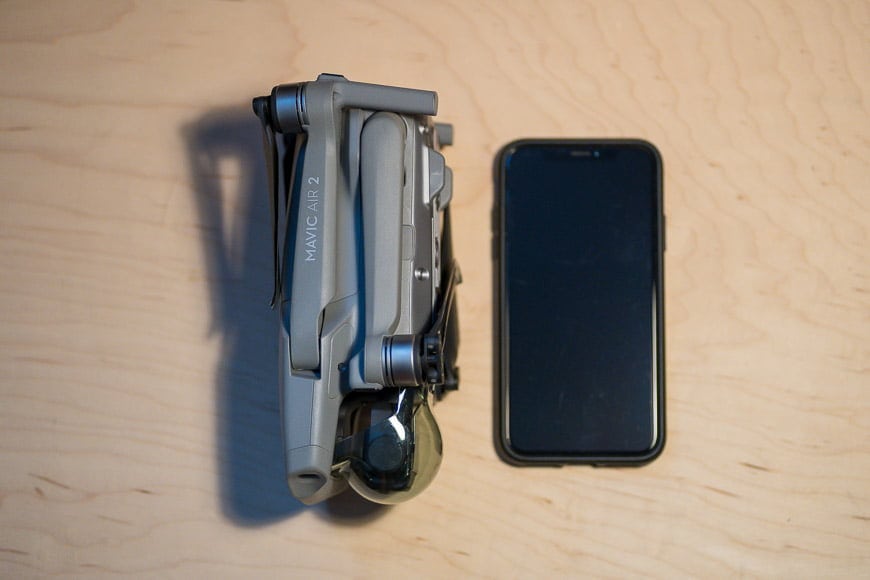
DJI Mavic Air 2 vs iPhone XS size comparison.
A few small improvements that made the DJI Mavic Air 2 stand out for me included the simplified one-piece gimbal cover and the ability to mount your phone in the controller without removing the case.
There’s also a built-in alert system for manned aircraft. I’ve never received any warnings through this feature (probably because I typically fly in remote areas of the mountains) but it’s nice to know that DJI is interested in improving their interface to avoid interactions with aircraft.
The other improvement DJI made was in the obstacle avoidance. It appears to be more responsive and effective at avoiding crashes by sensing obstacles in front, back, and downward directions.
When it comes to flying a drone, there are a few accessories that also become important to consider.
First off, additional batteries are really nice to have (although the 34-minute flight time will allow multiple flights). The worst feeling is having an amazing photo opportunity and getting the battery-low warning just as you’re about to capture something awesome.
If it’s your first drone, I highly recommend extra props. Because DJI drones are so durable, they will likely keep flying after a crash but broken props (very inexpensive) will need to be swapped out. Keep several extras around and don’t worry about crashing.
Lastly, having a landing pad for taking off in wet, dusty, or uneven terrain is really helpful. You can also master the hand launch/landing but that takes a little more skill (and you risk seriously painful cuts on your hands from sharp propellers).
Once you have all these accessories, a case to put them in is very helpful. It will keep you organized and ensure you’re not looking for filters when you want to be shooting the sunset.
Value for Money
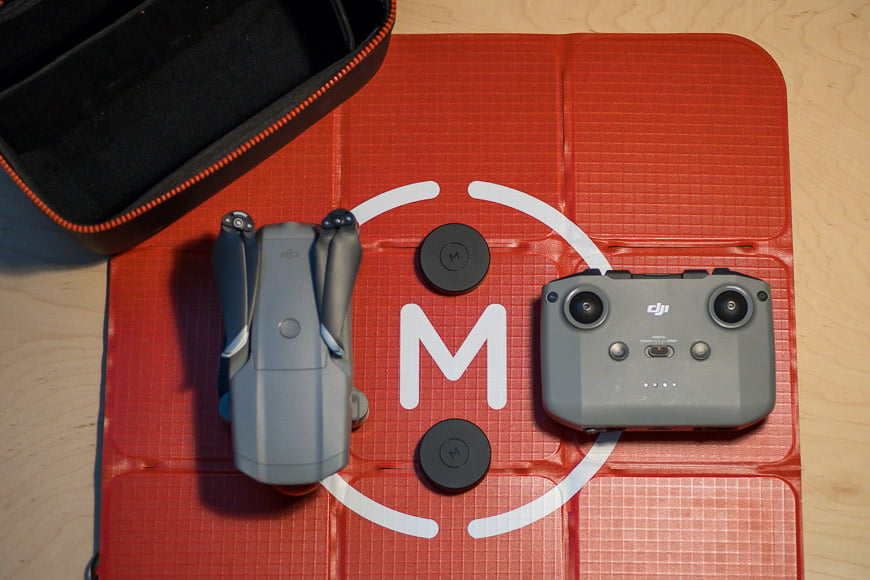
This review was made possible thanks to our friends at Moment – be sure to check out all their amazing gear and content.
For the performance you get, the DJI Mavic Air 2 is excellent value. It offers incredible flight time, impressive photo/video specs, and a very compact size.
At around US$800, this drone is competing with much higher priced drones when it comes to specs. With the advent of so many choices in the drone world, it can be difficult to decide, but the DJI Mavic Air 2 is an excellent option.
The biggest value for me with this drone is the ability to capture 48-megapixel still images. Because the images are such good quality, it makes this drone far more appealing than some of the lower resolution options.
If you’re interested in a drone, the DJI Mavic Air 2 is one of the best offerings on the market when it comes to balancing value/specs/size.
DJI Mavic Air 2 Drone Review | Conclusion
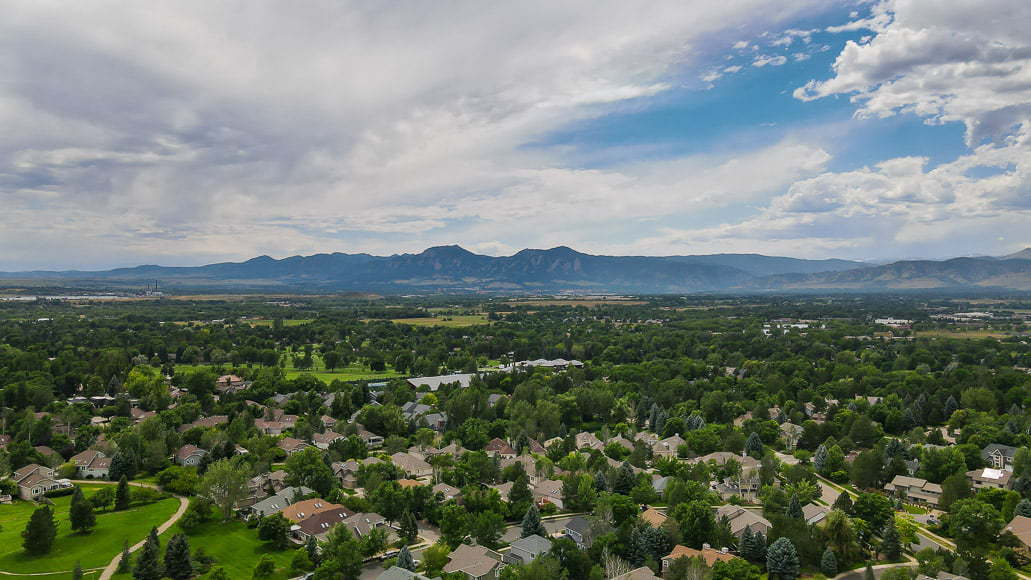
DJI Mavic Air 2 | 1/1250 f/2.8 ISO 100
The DJI Mavic Air 2 is an incredible drone and because of that, I will definitely be adding it to my camera bag. It makes my older Mavic Pro nearly obsolete when it comes to photo and video specifications.
For the price, the DJI Mavic Air 2 can’t be beat. It offers such good quality at such a good price that I think it’s the current champion of the DJI lineup. I’ll be using this drone until the Mavic Pro 3 comes out.
With the limitless options drones provide, it’s awesome to see DJI putting out such a competitive offering.
I love the creativity and flexibility that having a drone allows. I can move my camera into positions previously inaccessible and get perspectives that used to be impossible!
If you haven’t tried shooting with a drone, I highly recommend checking out the powerful and affordable DJI Mavic Air 2!

Capture butter-smooth 4k video and impressive aerial images with this 48-megapixel gem.





